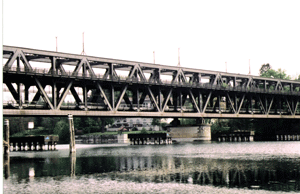|
It stands in the southern end of the Lake Maggiore, where
the lake comes back into river, and always played an important
part in the control of the road linked the Ticino River, and
therefore Milano and the Po Valley, to the Lake and the Europe.
Its very ancient origin has been testified
by several finds discovered in all the area. Certainly since
the ancient times primitive peoples lived here as the erratic
boulder 'Sass da Preja Buia' with its incision evidences.
As well several are the evidences of the Bronze Age and Iron
Age; the Golasecca Civilisation over all.
In the VI century there was a settlement that
ran the trader on this important water way. Later, Gauls and
Romans followed one another. And finally in the XII century
it was under the Visconti rule; then under the Cusani in 1678.
Between the XIX and the XX century, many industrial
factories developed. In 1882 was built the double iron bridge
over the Ticino River and Sesto became also an important railway
joint. In 1915 has been established the SIAI, one of the most
important italian aircraft industry.
To see:
- the Church of San Donato, has been
founded by Liutardo, Bishop of Pavia, from 830 to 864, but
the today architectural appearance dates XI-XII century. Stones
with interlaced decorations dating to the early Middle Ages,
a Romanesque coffer, a Roman funerary engraving are visible
on the outside walls to testify its hystory. Inside there
are frescoes by Cesare da Sesto (XVI century) and Paolo Baroffio
and Biagio Bellotti (XIX century).
- the Oratory of San Vincenzo, dated
XI-XII century and built on older place of worship datable
to the V-VI century. Numerous tombs have been found outside
the church as well as beneath the building's floor.
-the Sass de Preja Buja, close
to the Oratory of San Vincenzo, with some engraved cupels
on the upper face
- the Museo
Civico Archeologico Naturalistico

The double bridge
|


 Hotel
Hotel
 Camping
Camping
 Bed
& Breakfast
Bed
& Breakfast  Residence
Residence
 Room
Room
 Restaurant
Restaurant
 Farm
holiday
Farm
holiday 